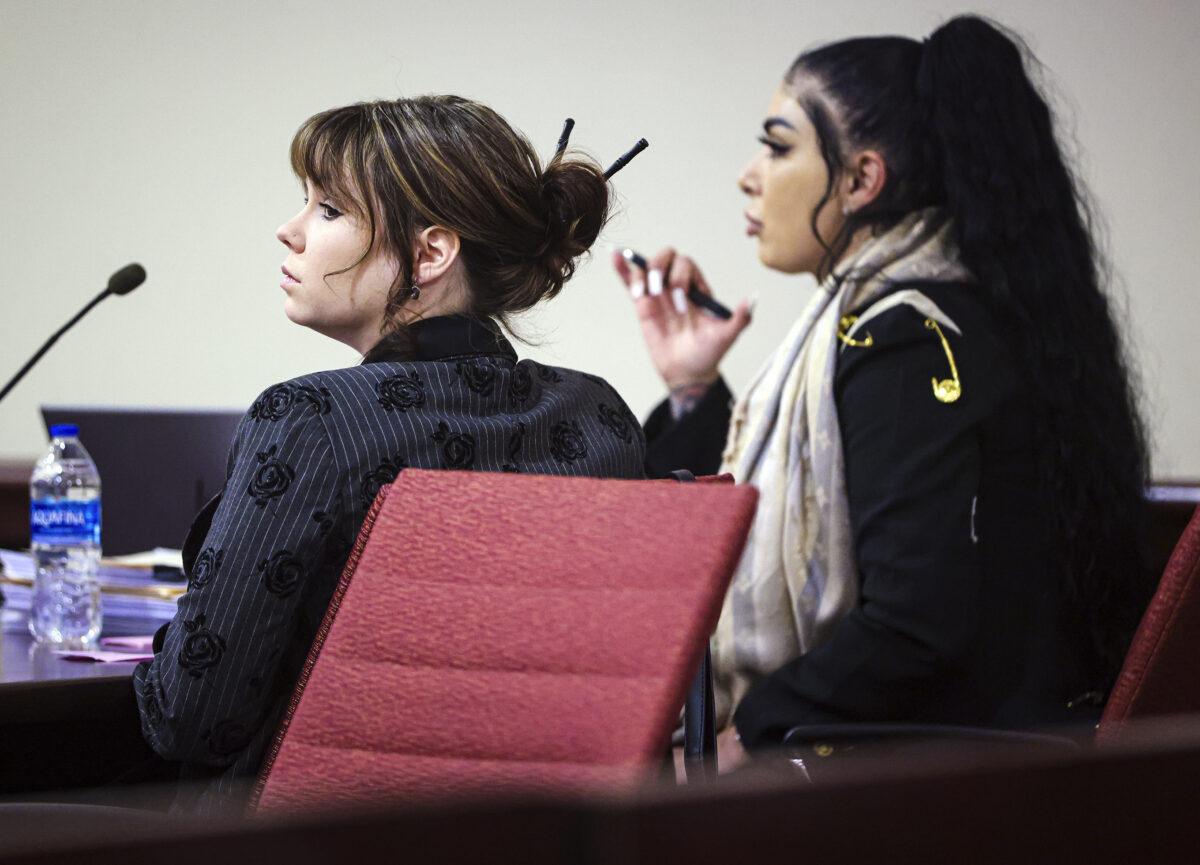
Hannah Gutierrez-Reed, left, listens to a crime-scene technician being questioned during her trial at the First Judicial District Courthouse in Santa Fe, New Mexico, on Friday, Feb. 23, 2024. (Gabriela Campos/The New Mexican via AP, Pool)
SANTA FE, New Mexico—Courtroom testimony by an independent gun expert Tuesday, Feb. 27, cast new doubt on Alec Baldwin’s account that his gun went off without pulling the trigger in the fatal shooting of a cinematographer during a 2021 rehearsal on the set of the Western movie “Rust.”
Baldwin has pleaded not guilty to involuntary manslaughter with a trial scheduled for July in the death of cinematographer Halyna Hutchins during a movie rehearsal on the outskirts of Santa Fe.
“Rust” armorer Hannah Gutierrez-Reed is currently on trial for her possible role in the death, pleading not guilty to charges of involuntary manslaughter and tampering with evidence. The armorer’s trial has complex implications for Baldwin, who has not appeared in court.
On Tuesday, firearms expert Lucien Haag provided a lengthy demonstration of the workings of a single-action Colt revolver, like the gun held by Baldwin, and safety features that prevent a fully cocked hammer from striking and firing ammunition unless the trigger is depressed.
An FBI expert testified in court Monday that the revolver used by Baldwin was fully functional with safety features when it arrived at an FBI laboratory. The expert said he had to strike the fully-cocked gun with a mallet and break it in order for it to fire without depressing the trigger.
Haag, an Arizona-based consultant and expert in Old West firearms, testified Tuesday that he saw no evidence that the gun was broken or modified before it was tested by the FBI.
“Have you seen any evidence that the full-cock hammer or notch was filed or modified to allow faster shooting?” prosecutor Kari Morrissey asked. “No,” replied Haag.
Haag and a colleague reassembled the gun with only one damaged part—the hammer—to demonstrate that safety features still functioned anyway—stopping the hammer under a variety of circumstances when the trigger was not depressed.
The jury watched a video of that experimentation with Baldwin’s gun, as the hammer was pulled back and released multiple times—and caught each time by a safety notch before it could strike the ammunition chamber to fire the gun.
READ: Alec Baldwin seeks ‘speedy’ manslaughter trial for ‘Rust’ film death
“If you’re trying to cock the gun and you lose your grasp on it, the hammer falls—that safety notch captures it,” Haag said.
The lead detective in Santa Fe on the “Rust” investigation said she was notified that the FBI would perform testing on Baldwin’s gun that might damage or destroy the gun.
“We proceeded with the testing because Mr. Baldwin had made statements that he didn’t pull the trigger. And I think his exact statement was that the gun just went off,” said Alexandra Hancock, the detective for the Santa Fe County sheriff’s office. “So we needed to figure out how to disprove that theory, or that statement. And that was the way that was proposed to us, and what the FBI could do.”
Defense attorneys for Gutierrez-Reed say problems on the “Rust” set were beyond the control of their client and have pointed to shortcomings in the collection of evidence and debriefings after the fatal shooting. They say the main ammunition supplier to “Rust,” Seth Kenney, wasn’t properly investigated.
Hancock delved into her investigation of both Gutierrez-Reed and Kenney during extensive testimony Tuesday, while reviewing a series of videotaped interviews with Gutierrez-Reed on the “Rust” set in the immediate aftermath of the shooting on Oct. 21, 2021, later that day at an interrogation room and again weeks later. Gutierrez-Reed has not testified at trial, though she has been in attendance behind the defense table.
The initial video from a police lapel camera shows a crestfallen Gutierrez-Reed shortly after the fatal shooting.
“Welcome to the worst day of my of my life,” the armorer told the detective after the shooting, but before she knew of Hutchins’ death. “I can’t believe Alec Baldwin was holding the gun.”
Prosecutors highlighted inconsistencies in the videotaped statements by Gutierrez-Reed, debunking her claim to have inspected all rounds in Baldwin’s gun prior to the shooting by shaking them for a telltale rattle. That shake can identify inert dummy rounds where gunpowder has been replaced by BBs, but investigators say at least one round contained no BBs and was marked as a dummy by a hole in the side.
Hancock testified that she investigated Kenney initially as the potential source of live ammunition, which is expressly prohibited on movie sets, but found out that he never went to the set of “Rust” and that a search of his property in Albuquerque turned up live rounds that didn’t resemble live rounds later discovered on the set of “Rust,” including the round that killed Hutchins.
Meanwhile, Gutierrez-Reed told investigators in November 2021 that she retrieved loose ammunition from a bag left over from work on a prior film, checked that they were dummy rounds and brought the rounds in two boxes to the “Rust” set. She said that ammunition first sat in her car for two weeks.
Questioned about any possible sabotage by cast or crew members, Gutierrez-Reed dismissed the idea and said no one there was “that malicious.” Six members of the film crew walked off the job the night before the fatal shooting in a dispute involving working conditions.
Gutierrez-Reed also previously told investigators including Hancock that Baldwin talked on his phone during a firearms training session for “Rust,” indicating he may have been distracted.
Defense attorneys did not yet have the opportunity to cross-examine Hancock on Tuesday.
Prosecutors argue that Gutierrez-Reed is to blame for bringing live ammunition on set and that she treated basic safety protocols for weapons as optional. They say six live rounds found on the “Rust” set bear identical characteristics—and don’t match live rounds seized from the movie’s supplier in Albuquerque.